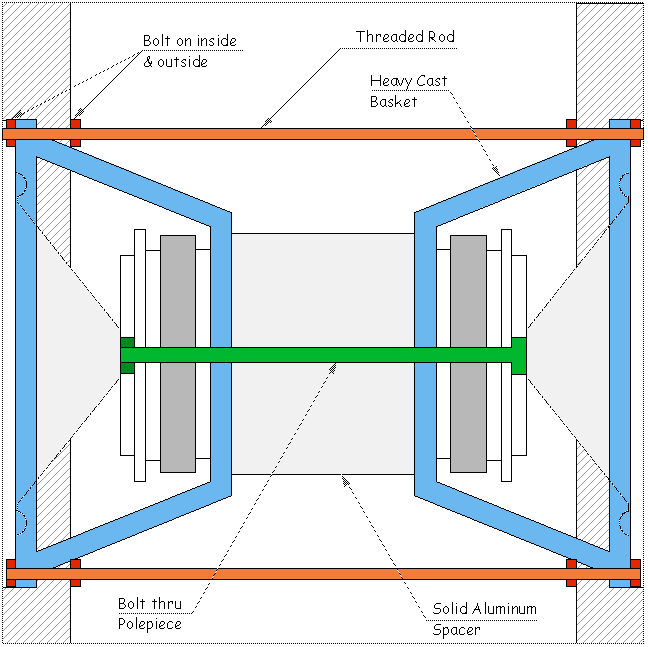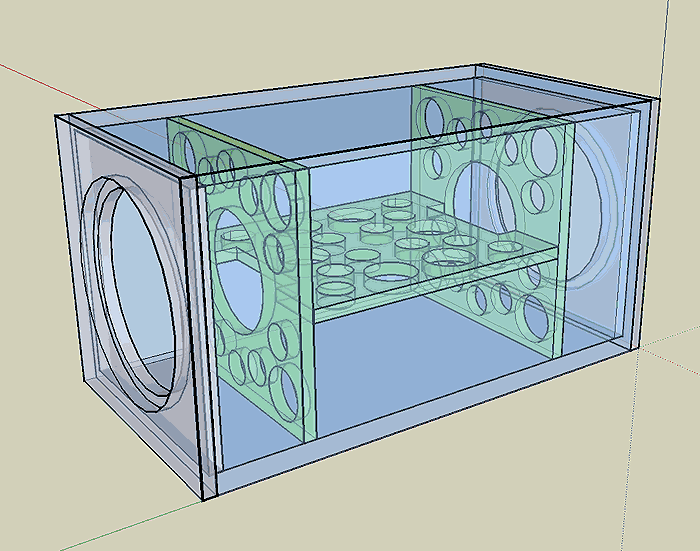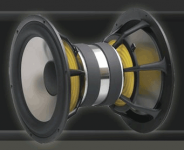Take a look at this.
I want to understand the "Dual force canceling subwoofers" they speak of... What is the principle? Is it some severe thing or something as simple as reversing the phase of one of the two subwoofer signals?
I want to understand the "Dual force canceling subwoofers" they speak of... What is the principle? Is it some severe thing or something as simple as reversing the phase of one of the two subwoofer signals?
An externally hosted image should be here but it was not working when we last tested it.
Last edited:
The drivers are acoustically in phase (as they move out, they pressurise the room), but mechanically, they move in opposite directions.
I designed my last subwoofer and speakers with a similar thing in mind, as (being 16) I live with my parents, who don't enjoy bass comming through the ceiling.
Chris
I designed my last subwoofer and speakers with a similar thing in mind, as (being 16) I live with my parents, who don't enjoy bass comming through the ceiling.
Chris
Imagine a subwoofer with a huge super heavy 18" cone on the front.
Sir Isaac Newton told us that for every action there is an equal and opposite reaction.
Therefore, as the cone moves in and out, the cabinet must rock back and forth slightly to compensate. This generates slight acoustic vibration into the air and probably into the floor.
Now if you mounted an identical cone on the back, with the same polarity, the mechanical motions cancel. When both cones move in or out, there is no net momentum and the cabinet won't rock (at least not due to the cone motion).
Sir Isaac Newton told us that for every action there is an equal and opposite reaction.
Therefore, as the cone moves in and out, the cabinet must rock back and forth slightly to compensate. This generates slight acoustic vibration into the air and probably into the floor.
Now if you mounted an identical cone on the back, with the same polarity, the mechanical motions cancel. When both cones move in or out, there is no net momentum and the cabinet won't rock (at least not due to the cone motion).
Hi,
If you mechanically link the two opposite drivers you can decouple
the driver mountings from the cabinet without any real effect.
This is the ideal way of doing it, reducing direct cabinet vibration.
rgds, sreten.
If you mechanically link the two opposite drivers you can decouple
the driver mountings from the cabinet without any real effect.
This is the ideal way of doing it, reducing direct cabinet vibration.
rgds, sreten.
Hi,
If you mechanically link the two opposite drivers you can decouple
the driver mountings from the cabinet without any real effect.
This is the ideal way of doing it, reducing direct cabinet vibration.
rgds, sreten.
Which is exactly what Thomas Barefoot did here.
Also call push-push. Mechanical linkage is important... some commercial designs that use the enclosure as the linkage miss the point.
KEF can possibly be credited with the 1st commercial implementations.
This concept shows an extreme implentation including a specially executed woofer.
toobz woofer

Whenever possible i use this technique as it can remove a very significant amount of energy from the box, dramatically reducing boxiness and the likelihood of resonance excitation.
dave
KEF can possibly be credited with the 1st commercial implementations.
This concept shows an extreme implentation including a specially executed woofer.
toobz woofer

Whenever possible i use this technique as it can remove a very significant amount of energy from the box, dramatically reducing boxiness and the likelihood of resonance excitation.
dave
Thomas Barefoot
From the info, those are powered speakers, not active... do they actually use a passive XO on the woofers?
From the attached image, these guys do a good job of the push-push.
dave
Attachments
No they are fully active. These little ones use 50w for the tweeter, 100w for midwoofer and 200w for the sub.
US$ 2747.50 each at Vintage King. There could be a waiting list, studios buy them quicker than Thomas can make them!
Well, that´s a bit outside hobbyist $$$ league - but if you have ever seen a downfiring subwoofer playing hopscotch you understand Sir Isaac´s actio and reactio thingy and can imagine the amount of energy moving the box instead of kicking you where you want it. 😱
Dave, you can do good drawings I can´t...cabinet wall-to-wall braces right between the driver mounting screws? (And I prefer threaded inserts over T-nuts anyway, so why not sink them into the braces).
Pit
Dave, you can do good drawings I can´t...cabinet wall-to-wall braces right between the driver mounting screws? (And I prefer threaded inserts over T-nuts anyway, so why not sink them into the braces).
Pit
From the attached image, these guys do a good job of the push-push.
dave
Is such a driver combination available to DIY folks or is it some aftermarket proprietary thing? How are those two drivers attached to each other?
Dave, you can do good drawings I can´t...cabinet wall-to-wall braces right between the driver mounting screws?
Usually yes, since it rarely happens that you can get the magnets to touch.

(the magnet fits tightly into the female portion of the vertical braces. I'd also probably duplicate the horizonal brace rotated 90 degrees along the long axis)
I can dig up some more drawings already done to illustrate this....
I'm working on both a quad SDX7 push-push (with Alpair7 mid-tweeter) and a pair of push-push SX10 subwoofers.
dave
Is such a driver combination available to DIY folks or is it some aftermarket proprietary thing? How are those two drivers attached to each other?
I't pretty much has to be just 2 drivers with a metal ring that fits perfectly over the end plates...
An externally hosted image should be here but it was not working when we last tested it.
Install one driver (from the outside). Slip the ring over the backplate. Install the other woofer and slide its back plate into the ring. Since there is a big hole where the plate amp fits you can guide it manually
dave
- Status
- Not open for further replies.
- Home
- Loudspeakers
- Multi-Way
- What is a dual force canceling speaker?
